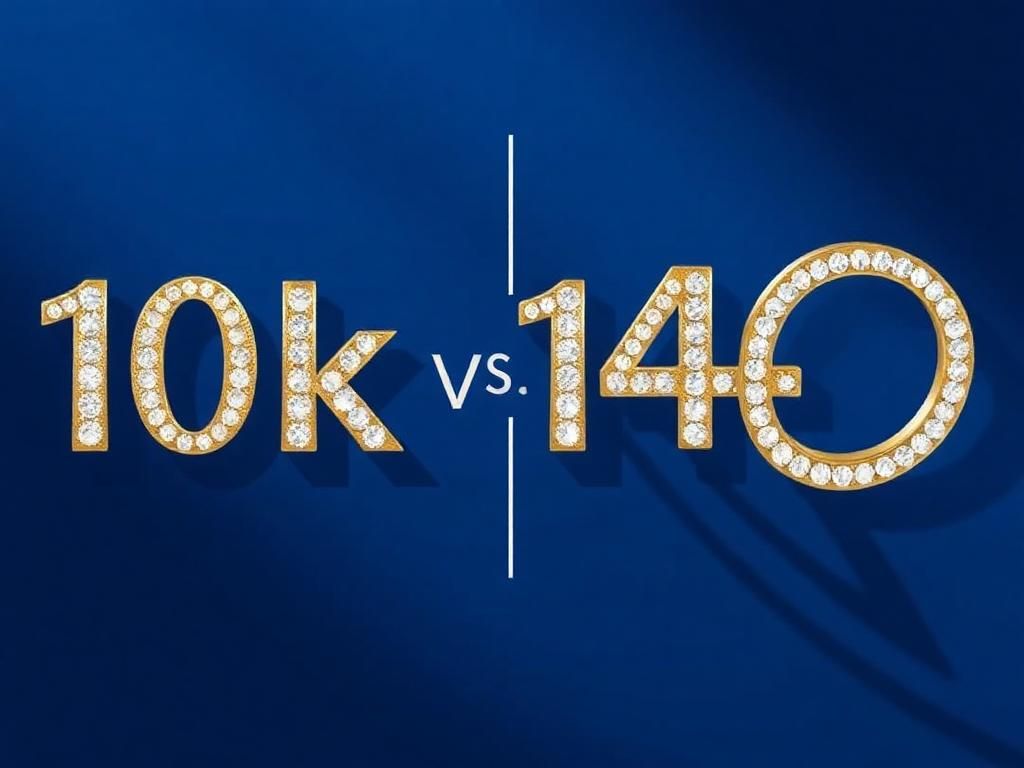Gold has long been considered a precious metal, revered for its beauty and value. As consumers navigate the world of jewelry, understanding the significance of karat is vital. Karats measure the purity of gold, and knowing the differences between 10k or 14k gold can help you make more informed purchasing decisions.
Understanding Gold Purity
What Does Karat Mean?
Karat (K) is a unit of measurement used to describe the purity of gold. A karat scale ranges from 0 to 24, with 24k representing pure gold, meaning it is 100% gold with no other metals mixed in. As the number decreases, the proportion of gold decreases as well. For instance, 14k gold contains approximately 58.3% gold and 41.7% other metals, while 10k gold consists of 41.7% gold and 58.3% other metals. Understanding this scale is crucial, as it impacts both the physical properties and value of gold.
Gold Purity Breakdown
To further illustrate the composition of 10k or 14k gold, the following breakdown shows the percentage of gold in each:
| Karat | Gold Content (%) | Alloy Metals (%) |
|——-|——————|——————|
| 10k | 41.7% | 58.3% |
| 14k | 58.3% | 41.7% |
This table provides a quick reference to the gold content in both types of gold jewelry, highlighting the differences in their respective purity levels.
Differences Between 10k and 14k Gold
Appearance and Color
When comparing the color variations of 10k or 14k gold, it is important to note that alloy metals influence the hue significantly. 10k gold tends to exhibit a slightly duller and lighter shade compared to 14k gold, which has a richer, warmer gold hue. This distinction in color can be particularly important when selecting jewelry based on personal aesthetic.

Durability and Strength
One key factor to consider when choosing between 10k or 14k gold is the hardness and durability of each type. 10k gold is more durable, making it an excellent choice for daily wear, as it stands up better against scratches and dents. Conversely, 14k gold is softer, which can make it more susceptible to wear over time, though it still retains a high degree of durability, suitable for various jewelry styles.
Price Comparison
When looking at the price trends between 10k or 14k gold, it is clear that 10k gold tends to be the more affordable option. The price of gold jewelry is influenced by several factors, including purity, market conditions, and craftsmanship. When budgeting for your purchase, consider how the karat impacts the price, and weigh your options based on your budget and quality preference.
Choosing Between 10k and 14k Gold
Personal Preferences
Choosing between 10k or 14k gold often comes down to personal preference. Individual style and aesthetic can play a significant role in this decision. Additionally, it is essential to consider any skin sensitivities or allergies to metals, as 14k gold contains less alloy and may be more suitable for sensitive skin.
Purpose of Purchase
The purpose of your purchase can also dictate which karat to choose. If you are looking for everyday jewelry, 10k gold is a practical choice due to its durability. However, for special occasion pieces or investment jewelry, 14k gold offers a beautiful appearance and higher resale value.
Longevity and Resale Value
The purity of gold significantly impacts long-term wearability, where 10k gold may last longer due to its hardness. However, 14k gold typically holds a higher resale value, making it a smart investment for those contemplating future sales.
Maintenance and Care

Cleaning Techniques
Regular cleaning maintains the luster of your jewelry. For both 10k or 14k gold, a gentle solution of warm water mixed with mild dish soap can be used to clean your pieces. Avoid harsh chemicals that could damage the alloy. Additionally, using a soft cloth can help maintain shine.
Storage Solutions
Storing your gold jewelry properly is crucial in preventing scratches and tarnishing. Keep your 10k or 14k gold pieces in a soft pouch or a fabric-lined jewelry box, separated from other jewelry items. This will help maintain their condition over time.
Conclusion
When choosing between 10k or 14k gold, it is essential to consider the key differences in purity, durability, and price. Making an informed purchasing decision can ensure that you find jewelry that meets your needs and lasts for years to come.
FAQs
Is 10k gold worth buying?
10k gold is considered a value option because it is more affordable while still maintaining a decent gold content. It is an excellent choice for individuals looking for durable jewelry at a lower price point.
Can you tell the difference between 10k and 14k gold without testing?
While you may notice differences in color and weight, it can be challenging to determine the karat without a professional test. Observationally, 10k gold appears lighter and duller than its 14k counterpart.
Is 14k gold better for sensitive skin?
Yes, 14k gold generally contains a lower proportion of alloy metals, which may reduce the likelihood of skin reactions for those with sensitivities.
How does the color of gold change over time?
The color of both 10k or 14k gold can change due to oxidation and normal wear over time. Regular cleaning and proper storage can help maintain the original color.
Additional Resources
To ensure your jewelry choices are made with confidence, consider visiting reputable jewelers such as [Jared](https://www.jared.com) and [Blue Nile](https://www.bluenile.com). They offer valuable insights and a wide range of options for jewelry care and authentic gold recognition.
With a better understanding of 10k or 14k gold, consumers can make informed choices that align with their preferences and needs in the jewelry market.